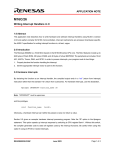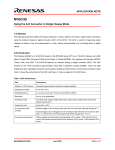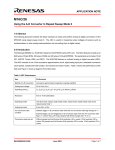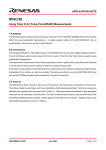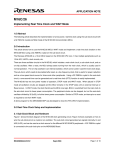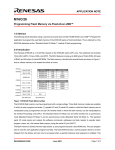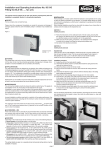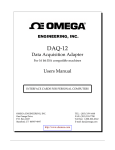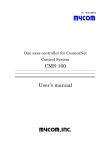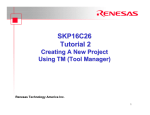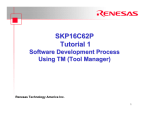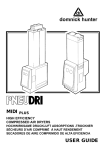Download M16C/26 Using the DMAC with a Forward Source
Transcript
APPLICATION NOTE
M16C/26
Using the DMAC with a Forward Source
1.0 Abstract
The following article introduces and shows an example of how to use the DMAC function of the M16C/26 with a
forward counting source address and fixed destination address.
2.0 Introduction
The Renesas M30262 is a 16-bit MCU based on the M16C/60 series CPU core. The MCU features include up to
64K bytes of Flash ROM, 2K bytes of RAM, and 4K bytes of virtual EEPROM. The peripheral set includes 10-bit
A/D, UARTs, Timers, DMA, and GPIO. The MCU has two DMAC (Direct Memory Access Controller) channels
that allow data to be transferred from a source memory location to a destination memory location without using
the CPU. The DMAC utilizes the same internal address and data busses as the CPU yet is given a higher priority
to the data bus than the CPU. This method of DMAC and CPU bus arbitration is termed “cycle stealing”.
Each DMAC controller is capable of transferring data to or from a fixed address to any other address within the
1Mbyte address space. The DMAC controllers can automatically transfer 128k bytes of data, using word (16-bit)
transfers, or 64k bytes of data using byte (8-bit) transfers. The source or destination address can also be
auto-incremented. DMAC transfers can be initiated by an interrupt request signal or by manually writing to the
software DMA request bit. When requests are initiated by an interrupt request signal, neither the interrupt enable
flag (I flag) nor the interrupt priority level affects the DMA transfers.
3.0 DMAC with Forward Source, Fixed Destination Description
In the forward source counting address, fixed destination address mode, the DMAC controller will transfer bytes
or words from an incrementing source address (increments after each transfer) to a fixed destination address.
The transfers can be either bytes or words. Loading a value into the transfer count register controls the number
of automated transfers. Transfers will continue to occur each time the DMAC trigger event occurs until the
transfer register underflows. Therefore, the number loaded into the register should be 1 less than the number of
transfers desired. A control register bit determines whether each transfer is a byte or word of data.
When the DMAC controller is configured to perform a single transfer cycle, the DMAC becomes disabled after
the transfer register underflows. In repeat mode, the Source Pointer register and the Transfer Counter register
are reloaded with their initial values after the Transfer Counter register underflows and the DMAC remains active.
Therefore, in repeat mode, transfers will occur each time a trigger event occurs until the DMA enable bit is set
inactive ("0").
REU05B0036-0100Z
June 2003
Page 1 of 7
M16C/26
Using the DMAC with a Forward Source
4.0 Configuring the DMAC for Forward Source, Fixed Destination
To configure a DMAC channel, the following choices must be configured (the configuration for this example are
shown in parentheses):
1. Select the DMA request cause by setting DM0SL register to 0x0a (UART0 receive interrupt request).
2. Select fixed or forward source (forward source) by setting bit-4 of DMCON register to 1.
3. Select fixed or forward destination (fixed destination) by setting bit-5 of DM0CON register to 0.
4. Select 8 or 16-bit transfers (8 bit transfers) by setting bit-0 of DM0CON register to 1.
5. Select a single transfer (single transfer) by setting bit-1 of DM0CON register to 0.
6. Select the source address for the transfer (Buffer address in RAM) by specifying SAR0.
7. Select the destination address (UART0 transmit buffer address) for the transfer by specifying DAR0.
8. Select the number of bytes to be transferred (10) by writing (9) in the Transfer Counter register.
The registers that are used to configure and control the DMAC channels are shown in Figure 1 and Figure 2.
Figure 1 DMA0 Request Cause Select Register
REU05B0036-0100Z
June 2003
Page 2 of 7
M16C/26
Using the DMAC with a Forward Source
Figure 2 DMA Control Registers
REU05B0036-0100Z
June 2003
Page 3 of 7
M16C/26
Using the DMAC with a Forward Source
5.0 Reference
Renesas Technology Corporation Semiconductor Home Page
http://www.renesas.com
E-mail Support
[email protected]
Data Sheets
• M16C/26 datasheets, M30262eds.pdf
User’s Manual
• M16C/20/60 C Language Programming Manual, 6020c.pdf
• M16C/20/60 Software Manual, 6020software.pdf
• Application Note: Writing interrupt handlers in C for the M16C
• MSV30262-SKP or MSV-Mini26-SKP Quick start guide
• MSV30262-SKP or MSV-Mini26-SKP Users Manual
• MDECE30262 or MSV-Mini26-SKP Schematic
6.0 Software Code
The example program was written to run on the MSV3062 Starter Kit but could be modified to implement in a
user application. The program is written in C and compiled using the KNC30 compiler. The program
demonstrates using the DMA0 channel to transfer data from a memory buffer to the UART0 transmit buffer. The
program performs a single transfer of 10 bytes to UART0. At the completion of the transfer a DMA0 interrupt
request is generated. UART0 on the starter kit board is connected to a 9-pin D-sub connector that can be used
to connect to a PC running a terminal program, such as HyperTerminal. With the program running, the data
contained in the DATA array will be sent to the terminal program and appear on the PC screen.
To run program perform the following steps:
1. Load program “dma_fs.x30” using KD30.
2. Set up COM port of PC and configure HyperTerminal to operate at 9600 BAUD, 1 Stop Bit, and No Parity.
Connect serial cable from COM port of PC to UART0 of starter kit board.
3. Execute program by pressing GO button on KD30 and “0123456789” will be displayed in the HyperTerminal
program window.
REU05B0036-0100Z
June 2003
Page 4 of 7
M16C/26
Using the DMAC with a Forward Source
/********************************************************************************
*
*
File Name: dma_fwd_src.c
*
*
Content: DMAC from a memory buffer to UART transmit buffer
*================================================================================
*
*
$Log:$
*================================================================================
*/
#include "sfr262.h"
#pragma Interrupt
/* SFR register definition */
dma0_isr
// prototypes
void mcu_init (void);
void uart_init (void);
void DMA_init (void);
unsigned const char *ptr_string;
unsigned const char data[]= "0123456789" ;
/*****************************************************************************
Name:
main
Parameters:
None
Returns:
None
Description: Initializes the system and then loops forever.
**************************************************************************/
void main()
{
ptr_string= &data[0];
mcu_init();
uart_init ();
DMA_init ();
dmae_dm0con = 1;
asm ("fset I");
te_u0c1 = 1;
//
//
//
//
//
//
//
//
initialize mcu to full Xin system clock
20 MHz in MSV30262 board
initialize UART0 and pre-load first character
in transmit buffer
initialize DMA registers
enable DMA transfers
enable interrupts
enable UART0 transmit
while (1);
//loop forever
}
/*****************************************************************************
Name:
DMA_init
Parameters:
None
Returns:
None
Description: Initializes DMA for transfer from forward source to fixed destinations
Set DMAC0 for 10 byte transfers from memory to UART0 transmit buffer
*****************************************************************************/
REU05B0036-0100Z
June 2003
Page 5 of 7
M16C/26
Using the DMAC with a Forward Source
void DMA_init(void)
{
dm0sl = 0x0a;
/* DMA0 trigger select UART0 transmit
00001010;
||||||||------(DSEL0) the four bits (DSEL3-DSEL0) the DMA
|||||||-------(DSEL1) request cause set for UART0 transmit
||||||--------(DESEL2)
|||||---------(DSEL3)
||||----------not used set to 0
|||-----------not used set to 0
||------------(DMS) DMA request cause expansion bit to normal
|-------------(DSR) set to 1 to generate DMA request if software
trigger selected */
dm0con = 0X11;
/* DMA0 single transfer, 8 bit mode, forward source,
fixed destination /*
00001011;
||||||||------(DMBIT) transfer unit bit select bit 1 = 8 bits
|||||||-------(DMASL) repeat transfer mode 0 = single transfer
||||||--------(DMAS) DMA request bit can only be set to 0
|||||---------(DMAE)DMA enable bit 0= disabled
||||----------(DSD)source address direction 1 = forward
|||-----------(DAD)destination address direction 0 = fixed
||------------not used set to 0
|-------------not used set to 0 */
dar0 = (unsigned long)&u0tb;
//
//
sar0 = (unsigned long)ptr_string;
// set source register to address of
// beginning of data buffer
// set transfer counter for 10 transfers
// (number of transfers -1)
tcr0 = 0x9;
dm0ic = 0x04;
//
//
set destination register to address
of uart0 transmit buffer
set interrupt priority for DMA0
interrupt to 4
}
/*****************************************************************************
Name:
dma0_isr
Parameters:
None
Returns:
None
Description: This service routine is entered after the completion of the DMA
transfer
*****************************************************************************/
void dma0_isr(void)
{
}
REU05B0036-0100Z
June 2003
Page 6 of 7
M16C/26
Using the DMAC with a Forward Source
/*****************************************************************************
Name:
uart_init
Parameters:
None
Returns:
None
Description: Initializes uart
*****************************************************************************/
void uart_init(void)
{
int dummy;
//
Configure Uart0 for 9600 baud, 8 data bits, 1 stop bit, no parity
u0mr = 0x05;
u0c0 = 0x10;
u0brg = 0x81;
// set mode register
// set control register
// set bit rate generator
// (20Mhz/16/9600)-1
u0tb = 0x20;
//
//
//
//
//
//
s0tic = 0x00;
Place data in the transmit buffer
so when the transmit enable bit is set
later on, this first byte will be sent
out and cause a UART transmit interrupt
to occurs triggering the DMAC
Disable UART0 receive interrupt,
}
/*****************************************************************************
Name:
mcu_init
Parameters:
None
Returns:
None
Description: Initializes mcu for full Xin system clock - 20 MHz in MSV30262 board
*****************************************************************************/
void mcu_init(void){ //Initialize mcu for sull speed (20MHz) operation
prc0 = 1;
cm0 = 0x08;
cm1 = 0x20;
cm2 = 0x0;
prc0 = 0;
/*
/*
/*
//
/* Unlock CM0 and CM1 */
Enable divider selected by CM1 */
Select no division, high Xin drive */
disable stop detection, main clock - Xin */
Lock the System Clock Control Register
}
REU05B0036-0100Z
June 2003
Page 7 of 7
Keep safety first in your circuit designs!
• Renesas Technology Corporation puts the maximum effort into making semiconductor products
better and more reliable, but there is always the possibility that trouble may occur with them. Trouble
with semiconductors may lead to personal injury, fire or property damage.
Remember to give due consideration to safety when making your circuit designs, with appropriate
measures such as (i) placement of substitutive, auxiliary circuits, (ii) use of nonflammable material or
(iii) prevention against any malfunction or mishap.
Notes regarding these materials
• These materials are intended as a reference to assist our customers in the selection of the Renesas
•
•
•
•
•
•
•
Technology Corporation product best suited to the customer's application; they do not convey any
license under any intellectual property rights, or any other rights, belonging to Renesas Technology
Corporation or a third party.
Renesas Technology Corporation assumes no responsibility for any damage, or infringement of any
third-party's rights, originating in the use of any product data, diagrams, charts, programs, algorithms,
or circuit application examples contained in these materials.
All information contained in these materials, including product data, diagrams, charts, programs and
algorithms represents information on products at the time of publication of these materials, and are
subject to change by Renesas Technology Corporation without notice due to product improvements
or other reasons. It is therefore recommended that customers contact Renesas Technology
Corporation or an authorized Renesas Technology Corporation product distributor for the latest
product information before purchasing a product listed herein.
The information described here may contain technical inaccuracies or typographical errors.
Renesas Technology Corporation assumes no responsibility for any damage, liability, or other loss
rising from these inaccuracies or errors.
Please also pay attention to information published by Renesas Technology Corporation by various
means, including the Renesas Technology Corporation Semiconductor home page
(http://www.renesas.com).
When using any or all of the information contained in these materials, including product data,
diagrams, charts, programs, and algorithms, please be sure to evaluate all information as a total
system before making a final decision on the applicability of the information and products. Renesas
Technology Corporation assumes no responsibility for any damage, liability or other loss resulting
from the information contained herein.
Renesas Technology Corporation semiconductors are not designed or manufactured for use in a
device or system that is used under circumstances in which human life is potentially at stake. Please
contact Renesas Technology Corporation or an authorized Renesas Technology Corporation product
distributor when considering the use of a product contained herein for any specific purposes, such as
apparatus or systems for transportation, vehicular, medical, aerospace, nuclear, or undersea
repeater use.
The prior written approval of Renesas Technology Corporation is necessary to reprint or reproduce in
whole or in part these materials.
If these products or technologies are subject to the Japanese export control restrictions, they must be
exported under a license from the Japanese government and cannot be imported into a country other
than the approved destination.
Any diversion or reexport contrary to the export control laws and regulations of Japan and/or the
country of destination is prohibited.
Please contact Renesas Technology Corporation for further details on these materials or the
products contained therein.








